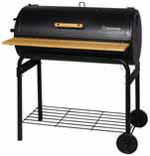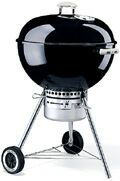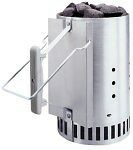|
Grilling season!
Some people love grilling so much that they declare it a 12-month occupation, dashing out to the deck or back yard to light up charcoal (or turn on the gas) even when it's freezing and snowy. I'm not that committed. When the weather outside is frightful, I'm happy in a cozy kitchen with the lights turned on and the thermostat turned up. But now that summer is here in full force, I've finally pulled the winter wraps off our barbecue grill, scoured off the worst of the crud that I failed to clean up last autumn, and have happily returned grilling to my culinary repertoire for the season. I like to think that there's more to quality grilling than simply lighting charcoal and slapping a chunk of meat over the fire until it's charred. With a little forethought, it's possible to enjoy almost as much heat control over charcoal as it is on your rangetop, but you have to approach it in a completely different way. While you can't simply turn the flame up or down with charcoal, you can easily build your fire in the first place so most of the heat is concentrated on one side (very high heat), a bit less on another side (medium heat) and very little over there (low heat).
Let's run through a few quick grilling points (and later I'll invite you to drop by our forum and add your own comments) before we get into today's recipe.
Recently (May 6), I offered a simple procedure for grilling asparagus, to which many of you responded with advice about enhancing all sorts of other veggies with the kiss of the primal fire. (Excuse me, please, there's something about grilling that inspires bad poetry.) Today let's try something a little more advanced: Slow, gentle warm-smoke cooking over indirect heat, following a quick hot-fire sear to get things started. This procedure works very well for whole chickens, leg of lamb, prime rib, or just about any good-size chunk of meat or poultry. I tried a slightly offbeat choice, a whole turkey thigh, with delicious results, enhanced by the feeling that I had somehow beaten the system, having invested a mere $3 and change (at the excellent but pricey Whole Foods Market) for a quality, naturally produced piece of turkey large enough to make an ample dinner for two with enough leftovers to build a couple of excellent sandwiches. INGREDIENTS: (Serves two)
1 turkey thigh, skin on and bone in 1. Start charcoal and give it sufficient time to light fully, the coals hot and covered with light gray ash. As noted in today's article, a "chimney starter" is the ideal way to light charcoal, and for this long, slow cooking technique, briquettes are perfectly satisfactory and may be preferable to quick-burning chunk charcoal. Put a few chunks of hardwood hickory, mesquite, or other aromatic wood of your choice into a bowl of water to soak for a half-hour or so. 2. Rinse and dry the turkey thigh. Rub it with a little olive oil and sprinkle it with salt and freshly ground black pepper. 3. When the coals are ready, set up your grill for direct and indirect heating, placing all the coals in a pile on one side (or in a circle), leaving the other side (or the center) clear. Drop one or two chunks of soaked aromatic wood on the coals. 4. Place the turkey thigh directly over the hot coals, skin-side down, and sear it, with the lid up, until the skin starts to turn crisp and brown, two to five minutes depending on heat. Turn it over and sear the other side for two or three minutes, watching carefully to ensure that it doesn't char. 5. Move the turkey to the indirect side of the grill, where it is not directly over the coals. Put on the lid, taking care to position the vents so natural air currents will direct smoke and warmth from the coals past the meat toward the vents. 6. Roast for 1 to 1 1/2 hours - slower is better - checking occasionally to turn the meat over and rotate it so all sides eventually face the fire, moving it closer or farther from the coals if it seems to be cooking too quickly or slowly, replenishing coals and wood chunks as needed. The thigh is done when no pink color remains and the juices run clear. (A smoke-tinged pinkish-brown edge, however, is normal in warm smoke grilling.) It's not a bad idea to check with a meat thermometer, taking care to place it in the middle of the meat, not touching the bone. (Food-safety experts recommend cooking turkey thighs to an internal temperature of 180F, which seems a little overdone to me, but if you get sick, don't say I didn't tell you this ...) 7. Allow the meat to sit at room temperature for a few minutes before slicing thin and serving. MATCHING WINE: This wine-friendly grilled dish would work well with a dry, herbal red or a full-bodied white. It was excellent with the modest, Merlot-like Calina 2001 Maule Valley Carmenere from Chile that was featured in Monday's 30 Second Wine Advisor.
PRINT OUT A COPY OF THIS RECIPE:
DISCUSS COOKING IN OUR ONLINE FORUM: Click the REPLY button on the forum page to post a comment or response. (If your E-mail software broke this long link in half, take care to paste it all back into one line before you enter it in your Web browser.) Let us hear from you! If you have suggestions or comments about The 30 Second Wine Advisor's FoodLetter, or if you would like to suggest a topic for a coming edition and recipe, please drop me a note at wine@wineloverspage.com. I really enjoy hearing from you, and I try to give a personal reply to all mail if I possibly can.
Of course you also have a standing invitation to participate in our interactive Food Lovers' Discussion Group. To participate in this friendly online community, simply click to Last Week's FoodLetter and Archives
• Last week's Wine Advisor Foodletter: Crab cakes revisited (June 3)
• Wine Advisor Foodletter archive:
• 30 Second Wine Advisor archive:
SUBSCRIBE:
Administrivia This is The 30 Second Wine Advisor's weekly FoodLetter. To subscribe or unsubscribe, change your E-mail address, or for any other administrative matters, please use the individualized hotlink found at the end of your E-mail edition. If this is not practical, contact me by E-mail at wine@wineloverspage.com, including the exact E-mail address that you used when you subscribed, so I can find your record. Thursday, June 10, 2004Copyright 2004 by Robin Garr. All rights reserved. FoodLetter archives Subscribe to the 30 Second Wine Advisor
|

 Years ago I invested in a hulking, locomotive-shaped iron barrel grill (New Braunfels Black Diamond from Texas -
Years ago I invested in a hulking, locomotive-shaped iron barrel grill (New Braunfels Black Diamond from Texas -  It's almost as easy to accomplish a similar purpose with the simple, circular kettle grills made by Weber (
It's almost as easy to accomplish a similar purpose with the simple, circular kettle grills made by Weber (



